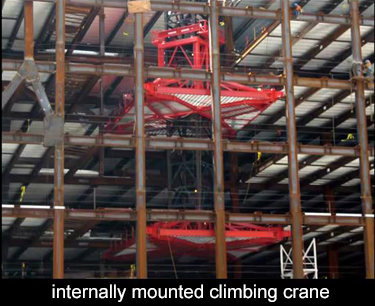Now that you've seen how tower cranes climb, what do you make of this crane, which does not have those features? The upper section is not larger than the remaining tower. The tower is uniform with throughout. The fact is, this tower crane does not climb. This crane is erected to that height. That is it's finished height, its final height. It will stay there and construct the facility. In this case, it's mid-rise building. At the completion of the building, it will be disassembled. This crane is lifted in place by means of other cranes.
This is a very nice view of the crane being assembled up in the air. It's a good place to remind you of some other features. The crane on the right is the lattice boom crane. The next crane, to its side, is a hydraulic crane, which has a telescoping boom. That is the significant difference between these two pieces of equipment. The hydraulic crane, when it's finished with its assignment here, will collapse the boom in a matter of minutes. The lattice boom crane needs to be disassembled using another crane. You can see it's joined together in sections.
The sections have to be dismantled, loaded onto trucks and driven away. The flexibility of the hydraulic crane is really remarkable and that's why it is such a popular tool. But there are trade-offs. The capacity of the hydraulic crane is probably only a fraction of the capacity of the lattice boom crane. In erecting the tower crane, it is probably taking both of those cranes. The crane on the right will make the heaviest pics and no doubt has made the initial pics to lift the portion of the crane that we see up there. The hydraulic crane can make subsequent small picks and the two cranes may work together to make some of the heavier pics.
This is a great view. You can see the workers are really very secure there. There's a broad walkway, a handrail. They're all securely tied off and when I look at this view, I'm reminded, if you are sitting in the cab of the crane, when the crane reaches way out and makes a heavy pick, the tower leans appreciably. I don't mean just the fraction of an inch. I mean, you really travels and then it is back into the upright position.
There's tremendous amount of movement there, which is not surprising giving the fact that this is a very tall cantilever and it's going to deflect significantly each time you pick up a load. I mentioned the trolley that rides along the outstanding boom of the tower crane, and you can see it here in midair. The worker is sitting right at the edge there, ready to guide it into place.
Now that you're familiar with how tower cranes climb and how they come down again, it's a very simple matter of the crane telescoping over the tower and that allows it to lift itself up and insert new pieces. At the same time, it can remove pieces on its way down.
Here's another tower crane being erected, and it works in a totally different way. This is a very efficient way. The tower crane attaches itself to the structural frame of the building. The steel here, shown in red, is the assembly that is carrying the load of the tower and it's attached to four columns of the building. I don't really know the details of this, but it seems to me that these four lugs that rest on the steel columns look like they are retractable. That's part of the process for this arrangement to climb. But this is just the initial stage where they are assembling the crane.
 In this photo, you can see all of the elements. At the lower level, there's that red frame which is attached to the building. Then there is an intermediate frame above that, which is a kind of a sleeve. The tower is actually fits inside that. That upper frame is also attached to the steel frame of the building. I don't know if it's possible for you to make this out, but you can see an ironworker, sitting here, working on a connection. We forget that at the end of the day, it comes down to the ironworkers getting the job done.
In this photo, you can see all of the elements. At the lower level, there's that red frame which is attached to the building. Then there is an intermediate frame above that, which is a kind of a sleeve. The tower is actually fits inside that. That upper frame is also attached to the steel frame of the building. I don't know if it's possible for you to make this out, but you can see an ironworker, sitting here, working on a connection. We forget that at the end of the day, it comes down to the ironworkers getting the job done.
Here is a nice overall view. At the lower level, the red frame is sitting on four brackets and it's attached to the steel columns. At this intermediate level, there's another similar looking device, which is just the sleeve and it's a guiding the tower, not really holding the tower up, It too, is attached to four columns. I have not seen this process in the works, but I can imagine what takes place is this sleeve is jacked up to its new position and I don't know if you can make it out, but there are brackets waiting to receive it on the four columns. It's jacked up to this position and, after it is secured, the lower portion is jacked up to this position. When the lower portion is jacked up, it's carrying the crane and everything. The entire assembly is moving up two stories